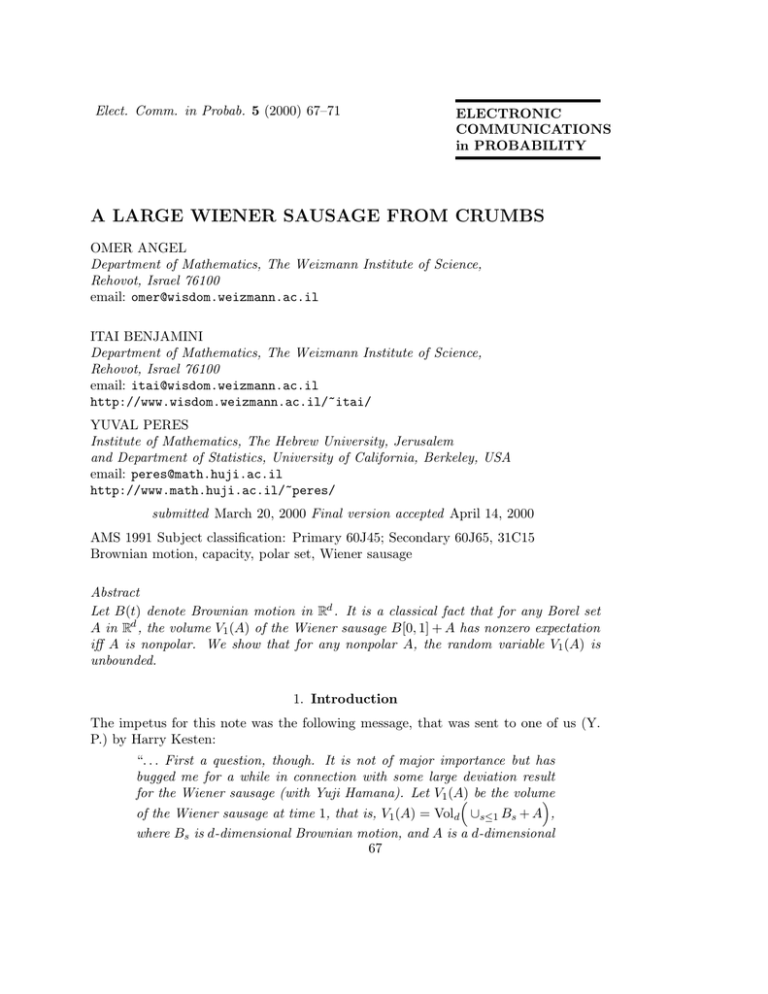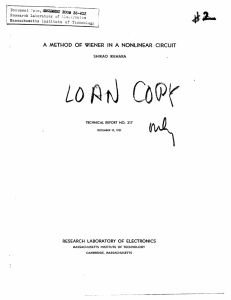A LARGE WIENER SAUSAGE FROM CRUMBS
advertisement

Elect. Comm. in Probab. 5 (2000) 67–71
ELECTRONIC
COMMUNICATIONS
in PROBABILITY
A LARGE WIENER SAUSAGE FROM CRUMBS
OMER ANGEL
Department of Mathematics, The Weizmann Institute of Science,
Rehovot, Israel 76100
email: omer@wisdom.weizmann.ac.il
ITAI BENJAMINI
Department of Mathematics, The Weizmann Institute of Science,
Rehovot, Israel 76100
email: itai@wisdom.weizmann.ac.il
http://www.wisdom.weizmann.ac.il/~itai/
YUVAL PERES
Institute of Mathematics, The Hebrew University, Jerusalem
and Department of Statistics, University of California, Berkeley, USA
email: peres@math.huji.ac.il
http://www.math.huji.ac.il/~peres/
submitted March 20, 2000 Final version accepted April 14, 2000
AMS 1991 Subject classification: Primary 60J45; Secondary 60J65, 31C15
Brownian motion, capacity, polar set, Wiener sausage
Abstract
Let B(t) denote Brownian motion in R d . It is a classical fact that for any Borel set
A in R d , the volume V1 (A) of the Wiener sausage B[0, 1] + A has nonzero expectation
iff A is nonpolar. We show that for any nonpolar A, the random variable V1 (A) is
unbounded.
1. Introduction
The impetus for this note was the following message, that was sent to one of us (Y.
P.) by Harry Kesten:
“. . . First a question, though. It is not of major importance but has
bugged me for a while in connection with some large deviation result
for the Wiener sausage (with Yuji Hamana). Let V1 (A)
be the volume
of the Wiener sausage at time 1, that is, V1 (A) = Vold ∪s≤1 Bs + A ,
where Bs is d-dimensional Brownian motion, and A is a d-dimensional
67
68
Electronic Communications in Probability
set of positive capacity. Is it true that the support of V1 (A) is unbounded, i.e., is P[V1 (A) > x] > 0 for all x? This is easy if A has a
section of positive (d − 1)-dimensional Lebesgue measure, but I cannot
prove it in general. Do you have any idea? ”
We were intrigued by this question, because it led us to ponder the source of the
volume of the Wiener sausage when A is a “small” set (e.g., a nonpolar set of zero
Hausdorff dimension, in the plane). Is it due to the macroscopic movement of B (in
which case V1 (A) would not be bounded) or to the microscopic fluctuations (in which
case V1 (A) might be bounded, like the quadratic variation)?
Our proof of the following theorem indicates that while the microscopic fluctuations of
B are necessary for the positivity of V1 (A), the macroscopic behaviour of B certainly
affects the magnitude of V1 (A).
Theorem 1. If the capacity C(A) of A ⊂ Rd is positive, then V1 (A) is not bounded.
The relevant capacity can be defined for A ⊂ R d with d ≥ 3, by
where
µ(A)2
C(A) = sup
µ E(µ)
ZZ
cd dµ(x) dµ(y)
E(µ) =
,
|x − y|d−2
and the supremum is over measures supported on A. (the constant cd is unimportant
for our purpose). A similar formula holds for d = 2 with a logarithmic kernel; in
that case C(A) is often called Robin’s constant, and it will be convenient to restrict
attention to sets A of diameter less than 1.
Denote by τA the hitting time of A by Brownian motion. By Fubini’s theorem
Z
E[V1 (A)] =
Px [τA ≤ 1] dx .
Rd
It follows from the relation between potential theory and Brownian motion, that
E[V1 (A)] is nonzero if and only if A has positive capacity; see, e.g., [3], [2], or [4].
2. The recipe
2
For any kernel K(x, y), the corresponding capacity is defined by CK (A) = supµ Eµ(A)
K (µ)
RR
where EK (µ) =
K(x, y) dµ(x) dµ(y) and the supremum is over measures on A. We
assume that K(x, x) = ∞ for all x, and that for 0 < |x − y| < RK , the kernel K is
continuous and K(x, y) > 0.
The following lemma holds for all such kernels.
Lemma 1. If a set A ⊂ R d has CK (A) >P0, then for any L < ∞ there exists > 0
and subsets A1 , A2 , . . . , Am of A such that m
i=1 CK (Ai ) ≥ L, and the distance between
Ai and Aj is at least for all i 6= j. (m and depend on A and L).
Proof: We can assume that diam(A) < RK , for otherwise we can replace A by a
subset of positive capacity and diameter less than RK .
Let µ be a measure supported on A such that µ(A) = 1 and EK (µ) < ∞.
A large Wiener sausage from crumbs
By dominated convergence,
ZZ
lim
δ→0
69
|x−y|≤δ
K(x, y) dµ(x) dµ(y) = 0.
Choose δ so that this integral is less then 2−2d L−1 . Let = δd−1/2 and let F be a grid
of cubes of side , i.e.,
F=
d
nY
o
[`i , `i + ) : (`1 , . . . , `d ) ∈ Zd .
i=1
o
n
We can partition F into 2d subcollections Fv : v ∈ {0, 1}d according to the vector
of parities of (`1 , . . . , `d ). Then the distance between any two cubes in the same Fv is
at least . Since µ is a probability measure, there exists v ∈ {0, 1}d such that
X
µ(Q) ≥ 2−d .
(1)
Q∈Fv
Let A1 , A2 , . . . , Am be all the nonempty
∩ Q : Q ∈ Fv }. Since µ is
P sets among {A
−d .
supported on A,RRwe can rewrite (1) as m
µ(A
)
≥
2
i
i=1
Denote by ei = Ai ×Ai K(x, y) dµ dµ the energy in Ai . Then
ZZ
m
X
ei ≤
K(x, y) dµ dµ < 2−2d L−1 .
(2)
|x−y|≤δ
i=1
By Cauchy-Schwarz,
m
m
m
X
X
2
µ(Ai )2 X
≥
ei
µ(Ai ) ≥ 2−2d .
ei
i=1
i=1
(3)
i=1
We have CK (Ai ) ≥ µ(Ai )2 /ei , whence
m
X
CK (Ai ) ≥
i=1
m
X
µ(Ai )2
i=1
ei
≥ L,
by (2) and (3).
Proof of Theorem 1: Suppose that
esssup V1 (A) = M < ∞ .
(4)
Let Vt (A) denote the volume of the Wiener sausage B[0, t] + A. From Spitzer [3] (see
also [2] or [1]) it follows that E[V1 (A)] > 2αd C(A) for some absolute constant αd . (If
d = 2 we assume that diamA < 1). We infer that E[Vt (A)] > αd tC(A) for 0 < t < 1,
by subadditivity of Lebesgue measure and monotonicity of Vt (A),
Fix L > 6M/αd , and let A1 , . . . , Am be the subsets of A given by the lemma. A
Wiener sausage on A contains the union of Wiener sausages on the Ai , and the sum
of their volumes is expected to be large. If we can arrange for the intersections to be
small, then V1 (A) will be large as well.
70
Electronic Communications in Probability
n
Consider the event
Hn =
max |Bs | <
1
0≤s≤ 2n
o
.
2
By Brownian scaling and standard estimates for the maximum of Brownian motion,
n2
).
4d
Choose n large enough so that the right-hand side is less than
E[V 1 (Ai ) | Hnc ] ≤ M by (4), so
P[Hnc ] ≤ 4d exp(−
1
nm .
For each i, we have
2n
E[V
1
2n
(Ai ) | Hn ] ≥ E[V
1
2n
(Ai )] − M P[Hnc ] ≥
For 0 ≤ j < n, denote by Gj the event that
max
2j
≤s≤ 2j+1
2n
2n
αd
M
C(Ai ) −
.
2n
mn
(5)
|Bs − B 2j | < /2
2n
and the first coordinate of the increment B 2j+2 −B 2j+1 is greater than the diam(A)+2.
2n
2n
Define G = ∩n−1
j=0 Gj . We will see that the expectation of V1 (A) given G is large.
2j 2j+1
On the event G, for each fixed j, the m sausages {B[ 2n
, 2n ] + Ai }m
i=1 are pairwise
disjoint due to the separation of the Ai and the localization of B in the time interval
2j 2j+1
[ 2n
, 2n ]. Therefore,
m h
2j 2j + 1
i X
αd
M αd L M
2M
E Vold B[ ,
]+A G ≥
C(Ai ) −
≥
−
>
.
2n 2n
2n
mn
2n
n
n
i=1
2j 2j+1
Also, on G, the sausages on the odd intervals, B[ 2n
, 2n ] + A for 0 ≤ j < n, are
pairwise disjoint due to the large increments of B (in the first coordinate) on the even
intervals. We conclude that
n−1
2j 2j + 1
i
X h
E[V1 (A) | G] ≥
E Vold B[ ,
] + A G > 2M .
(6)
2n 2n
j=0
This contradicts the assumption (4) and completes the proof.
Questions:
• Can the event G that we conditioned on at the end of the preceding proof, be
replaced by a simpler event involving just the endpoint of the Brownian path?
In particular, does every nonpolar A ⊂ Rd satisfy
h
i
lim E V1 (A) |B(1)| > R = ∞ ?
R→∞
• Can one estimate precisely the tail probabilities P[V1 (A) > v] for specific
nonpolar fractal sets A and large v, e.g., when d = 2 and A is the middle-third
Cantor set on the x-axis ?
Acknowledgments. We are grateful to Harry Kesten for suggesting the problem,
and for a correction to an earlier version of this note. We thank Dimitris Gatzouras
and Yimin Xiao for helpful comments. Research of Peres was partially supported by
A large Wiener sausage from crumbs
NSF grant #DMS-9803597 and by the Landau Center for Mathematical Analysis at
the Hebrew University.
References
[1] I. Benjamini, R. Pemantle and Y. Peres, Martin capacity for Markov chains. Ann. Probab.
23 (1995), 1332–1346.
[2] K. Itô and H. P. McKean (1974), Diffusion Processes and Their Sample Paths, SpringerVerlag.
[3] F. Spitzer (1964), Electrostatic capacity, heat flow, and Brownian motion. Z. Wahrschein.
Verw. Gebiete 3, 110–121.
[4] A. S. Sznitman (1998), Brownian motion, Obstacles and Random Media. Springer Monographs in Mathematics. Springer-Verlag, Berlin.
71









